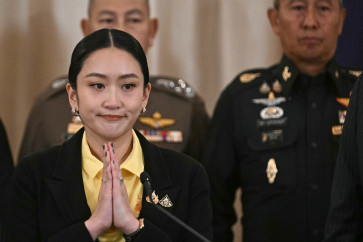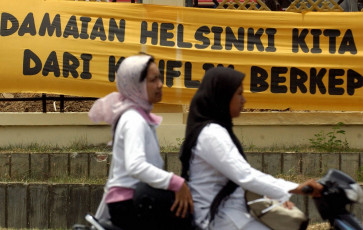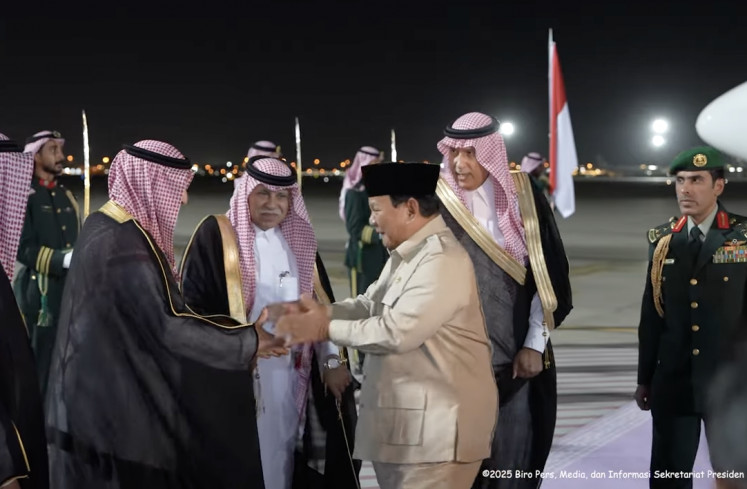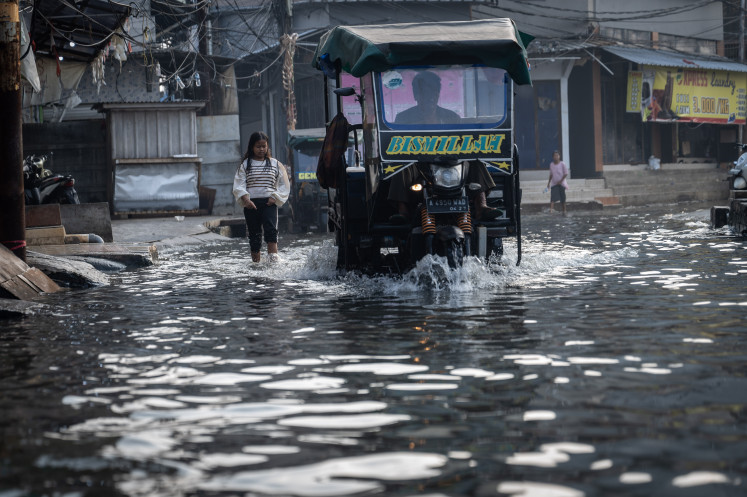Popular Reads
Top Results
Can't find what you're looking for?
View all search resultsPopular Reads
Top Results
Can't find what you're looking for?
View all search resultsWomen, youth and traditional cultures raise their voices
The Reform Era that began in 1998 not only resulted in the changing face of government and society, but also swept in fresh air and fresh voices in literature
Change text size
Gift Premium Articles
to Anyone

T
he Reform Era that began in 1998 not only resulted in the changing face of government and society, but also swept in fresh air and fresh voices in literature.
Most notably, the Indonesian literary world, long dominated by men, has been getting the woman's touch.
It was writer Ayu Utami who started the so-called sastrawangi (fragrant literature) movement with her novel Saman, published in 1998, kicking off the 2000s trend. The novel, which won the Jakarta Art Council award that same year, explored sexuality from a woman's perspective.
Ayu's novels were critically acclaimed not only in her home country, but also internationally. In 2000, she received the Prince Claus Award for Saman. Her 2008 novel Bilangan Fu (The Fu Number) won the Mastera (from the Southeast Asia Literature Board).
Saman opened up the field, and other women writers eagerly took the baton and ran with it. Some of the most notable were Djenar Maesa Ayu with her short story collection Jangan Main-main (Dengan Kelaminmu) (Don't Play (with your Genitals); 2004) and novel Nayla (2005); Dinar Rahayu with her novel Ode Untuk Leopold von Sacher Masoch (An Ode to Leopold von Sacher Masoch; 2002); Ana Maryam with her novel Mata Matahari (Eye of the Sun; 2003); Ratih Kumala with her novel Tabula Rasa (2004); Maya Wulan with her novel Swastika (2004); and Fira Basuki with her trilogy Jendela-Jendela (Windows; 2001).
As novels dealing with sex and sexuality began to crowd the shelves, both critics and proponents raised their voices. Among them were poet Taufiq Ismail, who said that genital literature had gone too far, and seasoned writer Sapardi Djoko Damono, who proclaimed that the future of Indonesian literature would be in the hands of women writers.
Richard Oh, co-founder of the Khatulistiwa Literary Award and owner of QB bookstores, said he had yet to come across any literary work as groundbreaking as Ayu Utami's Saman.
Yet Indonesian literature found its own yin and yang type balance. Counterbalancing the sex-themed books was a rise in literature with religious themes. This movement was led by the headscarf-wearing sisters Helvy Tiana Rosa and Asma Nadia and their Forum Lingkar Pena (FLP; The Pen Circle Forum).
In the hands of the FLP, novels with religious themes were simply built in a similar way to popular novels. One of the best-selling religious-themed novels of the decade was Ayat-Ayat Cinta (Verses of Love) by Habiburrahman El Shirazy, which encouraged the continuation of the trend, in the same way the film adaptation of the book sparked a phase of religious themes.
But despite the influx of Islamic-themed novels in the past few years, Richard said, it is one trend that is slowly receding.
Voices exploring or celebrating local traditions and societies also came to be heard in literature (although it seems that often these voices were drowned out by the more racy ones). One writer in this field looking is Wa Ode Wulan Ratna, whose short story "La Runduma" (2005) explores the clash between traditional culture and modernity. Other writers dealing with similar issues are Oka Rusmini with Tarian Bumi (The Earth Dance; 2000) and Kenanga (2003) and Abidah El Khalieqy with Geni Jora (2004). These two writers discuss their own local cultures in their books, with Oka focusing on Balinese culture and Abidah on Javanese.
Another interesting and notable literary work of this decade is the tetralogy of Laskar Pelangi (Rainbow Warriors; 2007) by Belitung-born writer Andrea Hirata.
The main theme connecting the books is the importance of education and daring to dream. The beauty of the works lies in their vivid descriptions, which makes readers feel the emotion in the pages, from the characters' emotional first day of school to the hardships the students must endure to get through school. Andrea is a young writer who made his debut with these books, based on his own experiences, which hit bestseller lists.
Richard said that young writers had the potential to start book trends as youth then became the major book buyers, while older readers tended to be drawn to more serious reading material, such as business and self-help books.
"It is difficult to find a market for fiction and literary works," he said. "I hope more publishing companies will publish such works."
Richard said that many young writers, such Raditya Dika and Ratih Kumala, had their own unique writing style and incorporated local content into their writing.
"Young writers have been creative by using a diary-writing style. I have yet to see one with a powerful theme, but most have interesting writing styles that resonate with their readers," Richard said.
Raditya Dika, blogger-turned-book writer, has produced several books, including Kambing Jantan (The Billy Goat; 2008) and Cinta Brontosaurus (Love Brontosaurus; 2006) Ratih Kumala has penned four books, including Tabula Rasa and Kronik Betawi (The Betawi Chronicles; 2009), about how massive development changes an area once known as Betawi and its residents, both physically and psychologically.
Richard said that it would be interesting to see more young writers exploring local cultures.
"At first, the young writers may be getting their style by following their favorite writers' style. But they will eventually grow their own style," he said.
"They can use the language of youth so it should not be too difficult to digest. It will also give readers plenty of choices for reading materials."
Given the local literary riches, Richard lamented the fact that publishers were translating international bestseller, such as Stephenie Meyer's Twilight saga and Helen Fielding's chick lit classic Bridget Jones' Diary.
"We have been late in picking up on book trends," he added. "When US and European readers are just getting bored with books, we are just starting with them."
Richard said that the readers in the US and Europe were helped in their decisions of which books to buy, with international publishing companies dividing books into categories, such as suspense and thriller, and international media outlets, such as The New York Times, putting out regular lists of bestselling books.
"Here in Indonesia, we have no such clear categories, and the media have never bothered to do any surveys of which books are selling the most."
Yet, he adds, it is aspects such as these that "help people determine which book may be interesting for them".
Given that Indonesia has a 9.6 percent illiteracy rate, according to the United Nations Development Program's (UNDP) Human Development Report for 2007, the industry and government may be focusing their resources more on school textbooks than on literary works. However, the decade has certainly recorded a heartening development.
Firdaus Oemar, chairman of the Alliance of Indonesian Bookstores, said that a 2008 government policy helped boost the textbook distribution. The policy stipulates that the government must buy the manuscripts of textbooks and distribute them for free over the Internet. As a result, the price of textbooks has dropped to one-third its previous price, meaning that - hopefully - more people will be able to buy textbooks.
According to Firdaus, the publishing world has been growing; there are now around 1,000 publishers in Indonesia, compared to about 500 publishers 10 years ago.
"Nowadays, there are 15,000 book titles published in one year, while a decade ago there were only about 3,000 book titles published per year," he said. "People's buying power has been increasing too, and there has been a surge in reading habits among urban people."
With the 2000s giving space to the voices of women, young people and traditional cultures, there is a good chance the Indonesian literary world will be able to continue growing in the next 10 years.









